Intro/Interview: Effraim.
It is hard to put into words the influence that the King of Ground contest has had on flatland since it’s inception, from all sides of flatland, the groundbreaking riding styles, the inside wooden contest floors, use of the battle format, waving of the flags for the judges result. I feel like no matter what I say, that would be only the tip of the iceberg.
I hit up Yasuyuki Takeo, one of the people behind the scenes that helped get the King of Ground up and running along with Takashi Ito, Kotato Tanaka, York Uno and a few others. I’ve lost track how many times I’ve posted a KOG video, and hit rewind numerous times just see what the hell happened. I wanted to know more about behind the scenes information of one of the most influential contest series to happen in flatland history.
Ladies and gentlemen, welcome to the Yasuyuki Takeo interview! In true Flatmattersonline style, it’s a long read, so grab a cuppa and get educated on all things KOG. So stoked how this came out, thank you Yasu for taking the time to do work on this interview.
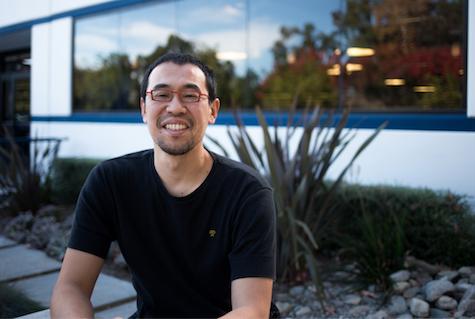
Hey Yasu, let’s discuss the history of the legendary King of Ground contest/series. First, please introduce yourself?
I’m Yasuyuki Takeo, an organizer of King of Ground from 2003 until 2016.
Can you recall when the King of Ground began? Where did the first contest take place?
The first competition was held on August 23rd, 1998 at ROX3 Super Multi Courte in Asakusa, Tokyo. One of the founder, Yoshi (Nakayama) worked as a manager at Rockslide, a shop carrying BMX in the ROX3. He had a couple of competitions or jams there, that was the reason why we made the decision for the first venue.
What was your initial philosophy running the contest?
It all started from the idle talk between Takashi (Ito) and Kotaro (Tanaka). There was a freestyle BMX championship organized by JFA (Japan Freestyle Association) but the organization was dismissed at the end of 1996.
Takashi and Kotaro were close to the organizers of JFA. The relationship nurtured them to have a broader perspective about the BMX scene rather than just riding themselves. They wanted a place where riders can push each other and opportunities where riders get more exposure in the public. BMX was way more minor sports than now. None of the riders could make living on riding.
Then York (Uno) jumped the gun with the “rumor” that Takashi and Kotaro would establish a championship. It was just a conversation and no actual plan. However, York’s move drove the plan moving forward into a reality. And then Akira (Okamura) also joined the organization team along with Yoshi (Nakayama, a friend of Kotaro and DJ) and Katsu (Sera, from Funfuncy inc, used to own Ares Bikes).
Members brought up some ideas about the name of the contest, but Takashi’s idea, King of Ground, was picked at the end.
I was just a participant in the beginning. But I got a slipped disc on my lower back in the summer of 2000, then York asked me if I can help them as a judge. They also struggled with a shortage of judges. It was the beginning of how I joined the KOG as an organizer.
Was it a series in the beginning, or did it build up to that?
It was planned to be a series in the second year. The first competition was held as an individual companion to prove the size of attendees, operation, and budget for the series following.
Who helped you get the event running?
The main members had changed a couple of times over 20 years. The original members mentioned above run for a couple of years, then I took over all responsibility in 2003. Regarding main members, riders from Fukushima, north part of Japan helped us from 2005 until 2009, and IPS, an event promotion company helped us from 2007 until the end, 2017.
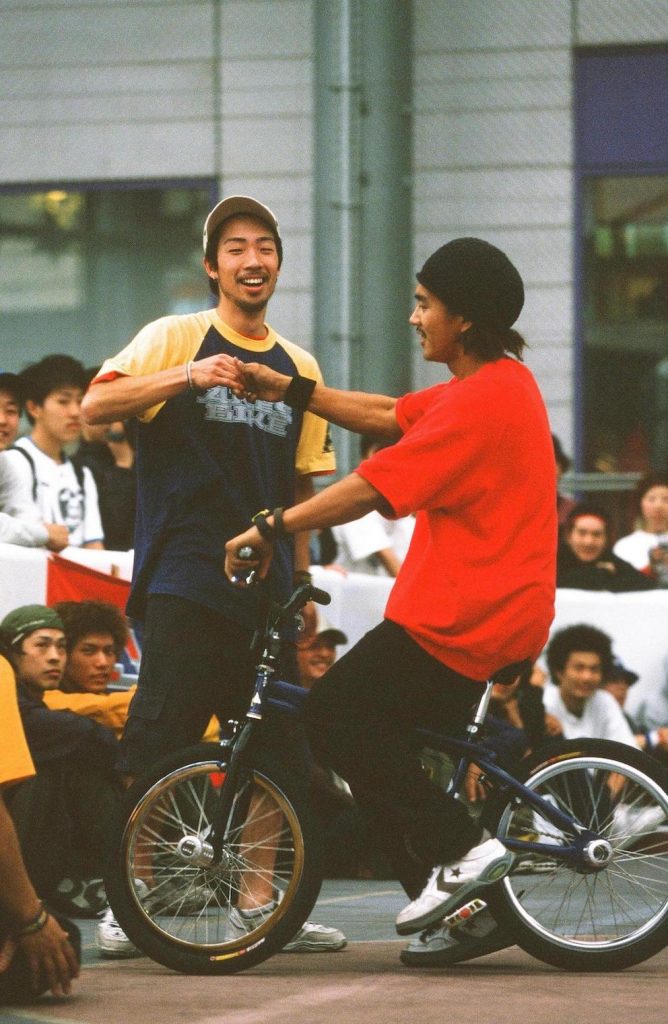
The founders of King of Ground, Takashi Ito and Kotaro Tanaka, circa 199.
Photo: Motoyoshi Yamanaka.
Did you finance the events yourself in the beginning or have sponsors?
The BMX scene was pretty small at the time, so each rider in the organization asked for their sponsors, such as BMX distributors, shoe brands, apparel brands, and even local retail shops where each rider belongs to. Also some medias such as Ollie and Bicycle Club supported us both exposure and budget.
We were all young and broken, Katsu, the owner of Funfuncy helped KOG for the initial cost. FunFuncy is one of BMX distributors and the manufacturer of Ares bikes. FunFuncy also managed finance and even provided their staff for administration voluntarily.
Looking back, How important do you think hosting the King of ground contests was to the growth of flatland in Japan?
KOG radically encouraged riders to be different than other riders and provided opportunities to manifest what’s valuable for Flatland as a consensus. It was the place to determine the aesthetics of Flatland, and even Judges weren’t an exception of the judgment.
Also, KOG provided opportunities for riders socializing in person and the encounter motivated riders going to local contests, to see friends and hang out besides of attending the competitions.
Those communications stimulated riders stayed at a local looking outside and brought out their talents, not only riding for competition but also performing at shows, for example. Those riders created another channel for the exposure of BMX themselves other than KOG and contributed to the expansion of the scene.
How long did the KOG run for before foreign riders started to attend?
KOG had a foreign rider for the first competition in 1998, Nathan Penonzek. His riding totally blew our mind at the time. After that, Japanese riders started competing at competitions overseas, and riders all over the world knew the level of Japanese Flatland scene along with the existence of KOG. In the meanwhile, that movement attracted more foreign riders visiting Japan later with curiosity.
That’s rad, how did Nathan Penonzek competing at the first KOG come about? Was that via Dig-it to promote Quamen?
Nah, Quamen didn’t exist at the time and Nathan rode for Rigid at the time. We didn’t know how he found out the information. He also won the first KOG.
KOG always seemed to pay attention to all classes, not just amateur and pro?
We simply followed the standard of competitions existing in Japan in the beginning, having Novice, Expert, and Pro.
However, from the beginning, we had the intention to motivate riders in the lower class aiming for stepping up to the Pro, and the champion of Pro class, “King of Grond”. This system worked well for attracting more riders to participate and generating a sense of unity across all riders attended, in the way of making all riders fell that they are part of the movement, not merely attending a competition.
The early days of KOG sustained the feeling of the good local contest even it was a serious championship. Looking back, it was a transition time until large scale type of competitions, such as X-Games emerging in Japan.
In terms of Girls class, the portion of riders was small, but riders were highly motivated and some of them even competed overseas. Looking at other street sports, or even general sports, a healthy ratio of gender is the essence of growth of the scene. It was the intention of investing in the Girls’ class.
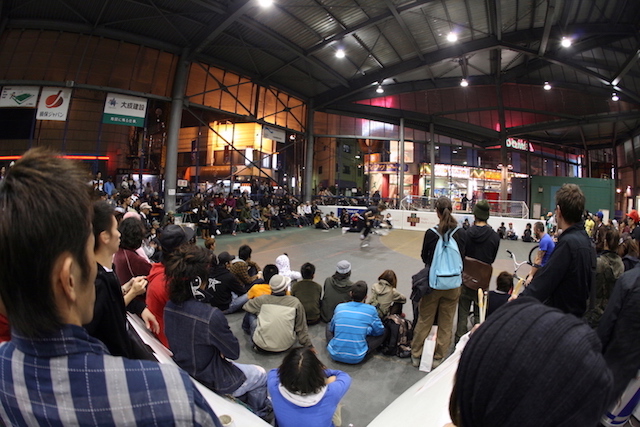
Free riding session after the competition at the Asakusa, Tokyo KOG, circa 2008.
Photo: Green G.
For me, looking at the Japanese scene. You guys always did a great job of feeding the next generation through. York is still very active right now for example with his YouTube flatland how-to videos? From the outside looking in so to speak, that seems like a real success story of the KOG?
Yeah, I agree. We didn’t mean to be intentionally investing only kids, young promising riders were one of accomplishment of KOG. Kotaro, Yasushi (Tanabe), Hiro, riders in Nagoya, they have been investing a lot for kids for years. The attitude also has been inherited to the seasoned riders around the late 20s and 30s.
From a different perspective, I’d say it is the consequence of investment by riders who own bike companies or have to do with bike shops for nurturing customers in the future. The number of those promising kids riders reflects the effort of those riders who make living on BMX too.
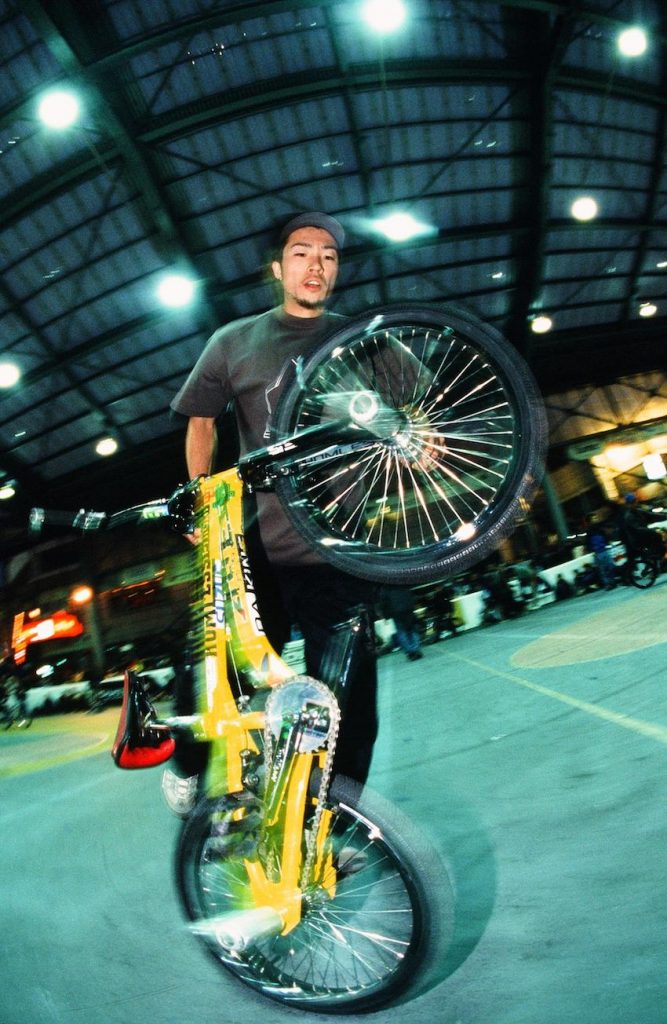
Takashi Ito, circa 1999.
Photo: Motoyoshi Yamanaka.
Running a contest, let alone a series is no easy task. Did you always have the same crew helping you?
We had regular members most of the time and they all helped us voluntarily. Looking back, I’m amazed that top riders like Takashi, Kotaro, York, Akira, Yanmar all helped preparation, which includes a lot of physical work, went out a party and drinking with locals “a day before of the contest”, and they still kept winning and beating up other riders.
In the meanwhile, the communication outside of competition might also contribute to the sense of unity, as riders see top riders not as “superstars”, they were one of them and friends.
Who took care of the judging? And what criteria did you use?
It’s changed over time. Early days, Takashi, Kotaro, York, Akira, Yanmar were in charge of the methodology and criteria. Every contest was an experiment due to no reference at the time. In the meanwhile, it also put huge pressure on us as no huge mess was allowed. We often discussed over the phone, and in-person sometimes until midnight before and after a contest.
The first version of the criteria was 5 different categories (Consistency, Difficulty, Originality, Variety and Overall). Then we changed it to the overall, and ranking conversion to eliminate deviation bias of each judge point difference between riders.
By 2003 or 2004, we could have a foundation of judge criteria for overall format and also all judges became more comfortable with the format. Participant riders often became judges so the experience from both perspectives might help them for the faster adoption. I started facilitating the judge criteria and format myself around the time.
In 2005, we first introduced the battle format with raising flags, but the results showed sort of bias for riders who have either Hanmer or flashy tricks. Riders started pointing out the side effects, that the battle format doesn’t reflect the real skills or nurture innovation, which KOG is supposed to value for.
However, in this period, we came up with the idea to use timers to allot riding time equally for each rider in the battle, and it soon became a standard of battle format. Hiroshi (Uehara, the owner of Fourthirty and a UCI certified international BMX Flatland judge) actively applied those new concepts to competitions outside of KOG that enormously contributed to the faster adoption of new concepts in the BMX scene.
We also tested mingled all formats for a series, Battle, The best trick oriented and overall for each contest, but ended up running all competitors with the overall format, and kept that way until the end.
The feeling I’m getting Yasu, is this event was totally organic. Riders helping purely for the love of the game, you are seeing a need to host the King of Ground series and making it happen. And learning all parts of the event organization as you go along the journey?
Right, volunteer spirit was implemented from the beginning. But the harder aligning the responsibilities in volunteers, the more you are responsible for the administration. There were a number of cases where the friendship and the sustainability of the series conflicted and sometimes ended up parting from them.
One important thing I learned in the journey was there’s a way even when you are in a bind, as long as you determine to move forward even only yourself.
Honestly, you couldn’t run a competition only by yourself, but you believe in it eventually for the scene, not self-serving, people will help you. I was an asshole sometimes, but I’m so thankful for people helping me in that situation.
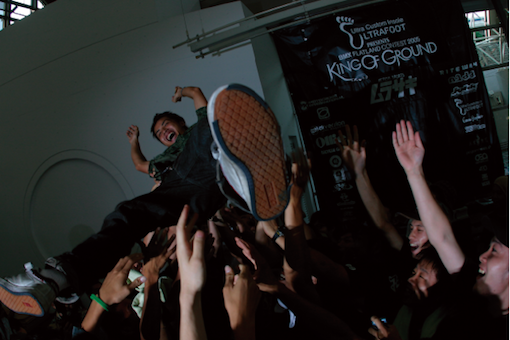
Yohei Uchino, the first pro victory at his local. Kobe, 2005.
Photo: Green G.
You mentioned the problems of battles favoring more flash riders, did you feel the KOG was getting away from it’s core values?
Yeah, sort of. The battle format noticed us what KOG is about. The diversity was key. I’ll explain more about this in the next question.
Which format do you think favors progressive riding in your opinion?
This may be an indirect answer, building an ecosystem including various perspectives would be a key. Let me explain the details later.
Only focusing on the competition perspective, the format would be ultimately overall, and the most all-round rider should be valued in a competition.
However, the way conflicts with the idea of “Freestyle”. Competition ultimately makes things measurable and authorizes judges’ take on official, whereas Freestyle ultimately values what you’ve never seen and opens up creativity for others, which implies breaking the current rule and presenting a new perspective that judges don’t have consensus how to judge.
This had been a dilemma since KOG started, how to balance between Freestyle and Competition, especially founders of KOG were all pursuing new inventions. The strategy of KOG was keeping riders involved in the discussion and assign themselves as judges, to have them revisit the consensus as KOG or even Flatland in Japan as a whole because there is no firm answer for this.
KOG experimented with various approaches over the years, but I couldn’t nail down the process in an appropriate way in the light of competition. That was my motivation to start publishing a magazine, to supplement the value other than competition.
Looking at Skateboarding, they have built a totally different ecosystem other than competition, such as a skater of the year, quality of footages, and the consensus of what is valuable regarding the approach to the spots and tricks. Those titles or recognition are honorable equality or even more than champions of competitions in some cases. Those ecosystems are also connected to skaters’ incomes more or less too.
Given that, Flatmatters, Master of Creativity, these media and movement are important in a way of nurturing diversity in Flatland. I’m really looking forward to seeing more opportunities coming up in the future.
How did you promote the event in the beginning Pre Internet, was there a Japanese magazine or something like that?
You’ll be surprised, it’s mostly by the word of mouth. There were a few magazines but we couldn’t publish the date due to the fact that we could always fix the date at really last minutes, say 2 weeks before in the worst case.
It wasn’t easy to find venues due to the price and lower availability of locations where expect more exposure to the general public. Popular venues were always fully booked as event companies book them throughout a whole year, so no spots left for a small, unknown organizer like us. Finding venues was one of those things we were concerned about all the time. In case of cancel, we could use them, but it’s always really the last minute that none of the other event organizers wouldn’t be interested.
At it’s highest point, how many riders did you have competing?
Regardless of such late notice, we had nearly 150 riders each competition, it once reached to over 200, I recalled it was the Tokyo round. Riders were so eager for the opportunities and started calling us (remember, it was before the internet era) a month or 2 months before the “expected date”, which we’d even officially announced. (laughter)
That’s so good! Did you have any background in organizing contests before you started the King of Ground?
No, not at all. Takashi used to have small jams called “Akiru Jam”, Akiru is the name of his local town. So Takashi has a little bit of knowledge, but I learned it through the KOG.
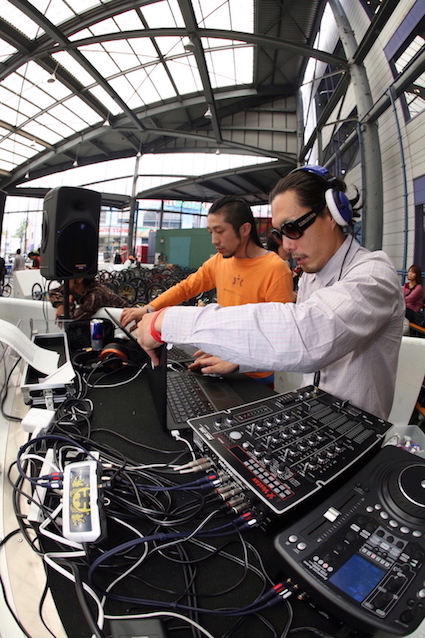
DJ UFO & York Uno at Asakusa, Tokyo, circa 2008.
Photo: Green G.
You were one of the first contests I recall bringing in a floor for the event regularly. What floor were you using? And how did that idea come about?
We had to lay plywood most of the cases as venues were indoor and covering the original floor was a requirement. We originally used plain 9mm plywoods as it was the thinnest and portable for our transporters (usually a small van, up to 4t loads). We just taped it on the original floor, but it couldn’t be attached to the original floor and curved quickly under the sun especially in the summertime, and riders actually complained a lot that it was slippery and hard to ride.
After the Circle of Balance in 2007, the event promotion company operated it, IPS started helping us. They rented us a space to store more equipment in their warehouse and they taught us to flatten the floor to use 24mm plywoods as the foundation and screw 9mm sand painted plywoods on top of it. It was honestly too sandy at the time (but no complaints that are slippery (laughter)), however, it gave us a lot of insights for the improvement.
With the experience of Circle of Balance in 2007, we started using matt gray, which prevents destruction due to shadows by lights, with finer sands in the paint for more grip.
Ah yes, I remember that really grippy floor. That was what we call a “rough sandtex paint”, so I’m thinking you went to the “ultra-smooth sandtex paint”? That’s what I use at Southsea Skatepark to help with grip on the ramps?
Yeah, it should be similar. I agree that COB’s floor was dangerously grippy. There were only 3 types of sands’ granularity available, so we ended up using the finer one for KOG. We used the most coarse one for COB.
Do you have a moment looking back, Where you thought this was a success and the KOG is really helping the scene?
There are a couple of moments in my mind. The time we had over 200 attendees in early 00’, when Ride BMX came to feature us for the first time, and Mark Eaton picked us up for Joe Kid on A Stingray video. Lastly, when Redbull asked us to be involved in the operation of Circle of Balance in 2007.
Takashi mentioned that every moment he heard the mix of sound that audiences cheering riders and thumping the partition, it was so special. I totally agree wit it. We’ve never experienced at any other competition.
The birth of the Internet helped to showcase what your team was doing to riders globally. Did you mention Nathan Penonzek competing, was that a real turning point in terms of international competitors? Like did you really notice the change?
Yeah, between 1998 and 2000 were the time where the situation had drastically changed. Nathan’s visit was the beginning of the movement. Nathan was outgoing and picked up Japanese really quickly, so I assume that he also bridged Japanese riders and other riders from different countries.
Meanwhile, riders called Top 6 at the time, Takashi, York, Kotaro, Akira (Okamura), Yanmar (Ryoji Yamamoto), and Hiro (Morizaki) started actively going to international competitions overseas after the first KOG, that triggered attracting more international competitors.
It mutually influenced and visiting the place was the best way to know up-to-date riding in person, before the Youtube era.
Over 200 attendees, wow that’s an amazing achievement! How important do you think hosting a series was to the development of flatland in Japan?
Having events periodically definitely contributed to accelerating the improvement of riding. From a socialization standpoint, KOG also provided opportunity riders for bonding tighter, especially at the time just the Internet emerged.
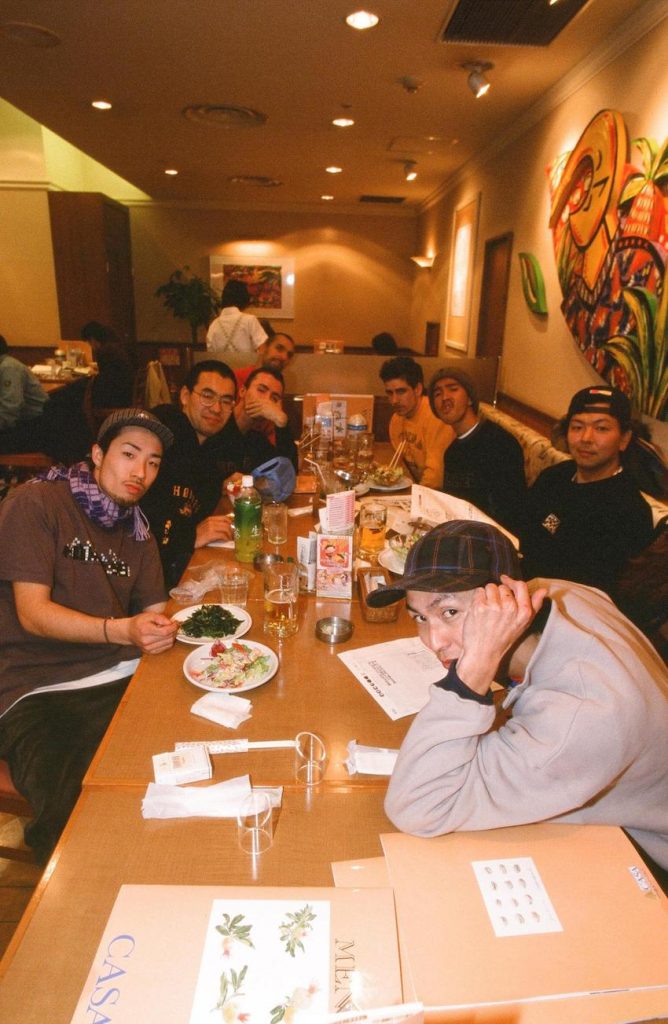
KOG meeting at night. From left: Takashi, Yasu, Alex Jumelin, Jimmy Petite, Kotaro Tanaka, Katsu and Akira Okamura. Circa 2001.
Photo: Motoyoshi Yamanaka.
After the Red Bull Circle of Balance in 2007, how did the KOG develop?
The largest influence was that Japanese riders started seeing an association between KOG, international competitions overseas, and prestigious invitational competitions as Circle of Balance (COB).
KOG had already enforced a Pro license system at the time, that Japanese riders won in an expert class or become an expert champion only can compete in the Pro class. There was no official alliance with other competitions per se, Japanese riders started presuming the Pro license as a passport to challenge international competitions and Pro class was seen as one of the qualifiers to be picked for such invitational only competitions.
The incident also opened up the organizers’ perspective for more possibilities. In 2007, Scott O’Brien, Michiel Verberg, and I established the world championship for Flatland, BMX Flatland World Circuit started to ally with each owned competition. The championship series was meant to be building another challenge for riders pursuing the best Flatland rider in the world.
However, the role was taken over to FISE, an official UCI backed world championship associated with the Olympic Games Committee, Flatark is another stream derived from KOG. Flatark is more rider oriented and encourages riders to purse their style, whereas FISE is obviously official athletic oriented competitions.
When was the last King of Ground contest?
The Round 3 in 2016.
Did you feel with the rise of the Flatark competition and Fise World Series you had done what you intended? Or something else entirely?
I’m just thankful to be able to see the possibilities of what we did. The only hope when I organized KOG and BMX Flatland World Circuit was making that movement sustainable without my help, by different bodies possibly for more scalability. In that sense, the current situation is what I wanted to see.
Flatark is really successful and getting bigger every year. I’m always amazed by the size and quality. I respect what Yohei (Uchino) have built so far and look forward to seeing what’s next.
FISE World Series was something more than that I could imagine as well as BMX Freestyle in the Olympic Games. Now I feel the sky is the limit. As an ex BMX magazine publisher and photographer, I want to see more movement at the cultural side, which would attract more people from different fields and develop more touchpoints to the general public.
If there was one thing you take away from helping to run the KOG, what would it be?
Friendship. Many friends at my age have left BMX and don’t see often than before, but friendship still remains tight. As I get older, I’m more thankful for that part.
What do you do nowadays Yasu?
I’ve been working as a software engineer for nearly 20+ years. I have a family now, my wife and one daughter, so the family is the first priority for now.
This has been amazing catching up Yasu! Any final thank you’s?
First of all, York for hooking me up for a judge of KOG when I got injured and was about to leave the scene. Hiroshi (Uehara) and Takashi (Ito) for helping me in many ways for years. Especially Takashi for helping me this interview better. Katsu (Sera) at Funfuncy for teaching me the basics of organization management. Tomoya (Watanabe) and Yutaka (Tamaki) for his contribution along with building an amazing administration team with young volunteers. Kazu and Seiko at IPS, an event company supported me and KOG voluntarily for over 10 years.
There more people I can’t cover here, thank you all! I know each of your contributions built the history of KOG!

Arigato Yasuyuki Takeo, I’ve nothing but respect for you for what you’ve done with King Of Ground not focusing on the specifics but across the boards especially paying close attention to all classes.
Nice interview and insight to the KOG
Thank you
Effraim and Yasuyuki
One love ❤️
Thanks Jesse!
Cool insight!
Thanks Sietse really enjoyed working on this interview and learning more about the KOG.
Thanks for this! A very nice perspective of what made the KOG series so well-respected, and how it served as both a blueprint for modern comps, and getting the Japanese riding scene world-wide exposure.
no doubt Dre!
Big respect and thank you from one rider in Japan.
Glad you enjoyed it Gunter… did you ever compete at a KOG?
Nice!
Do love a KOG, still!
Honorable article, contest and the riders/riding etc.
Winning viewing contest formula too. (imo)
Props y’all!
\roots.
Agree Trev.
How can you not love a KOG, amazing! The footage keeps coming, I’ve got some good ones for today!
Great glimpse of history we’d never get to know other wise. That’s crazy awesome to hear that Nathan Penonzek was one of the first to show up in their scene. Anyone else remember how his back wheel flow really brought back wheel only riding to the podium, and opened eyes to that concept of structuring your links and contest runs over one end of the bike? Damn! Just another sick example of how KOG showcased a wide variety of what flatland had to offer, and where concepts could evolve to. Not too long of a read at all, excellent flat content. Thanks as always for putting this stuff out for all of us!
Awesome interview! I remember when i started to ride and watched flatland manifesto vhs with KOG footage and tought how amazing should be there!
Thought I knew , having read about him in that Cream BMX magazine book that came out , Fall of 2007 , but…………I had no idea , just HOW MUCH this man has contributed to flatland bmx , GLOBALLY ! Mad RESPECT to you Takeo . Thanks , E for this sweet interview ….I just got seriously schooled , TIMES 7 ……..dudes like this KEEP the artform alive and thriving …….